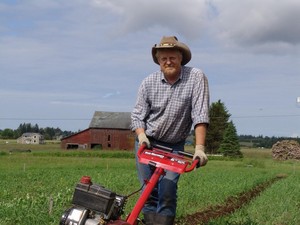29 Jan Sat 2011
Comment on Jason Bradford's Article "Oil and Food Prices"
Jason Bradford’s article, “Oil and Food Prices,” in the Energy Bulletin http://www.energybulletin.net/stories/2011-01-29/oil-and-food-prices, uses the same reasoning I have been proposing in public forums for the last three years and other authors have been proposing for much longer. Simply put, you can calculate energy inputs and outputs to provide a quantifiable measure of sustainability. If your energy output is smaller than your energy input, you are not sustainable.
Bradford’s example is the high energy cost of beef and calculates 26 units of energy to produce 1 unit of beef. The energy units can be gigajoules, as Bradford uses, or calories, as I favor. Either way, the 26:1 input/output ratio confirms what scientists and observers from outside the scientific disciplines have long known; that beef is not only a nutrient dense food, but also an energy dense food. All animal products are nutrient dense in comparison to plant foods. This is no surprise (and probably what accounts for our grotesquely enlarged brains over the last 2 million years!). What should cause concern, however, is how the animal products get energy dense.
If you eat "mainstream" corn-fed beef, there is a high energy cost because of the means of production and feeding grain to an animal adapted to grazing. If you eat grass-fed beef though, the farmer is likely raising the animal on ground that is only marginal for crop production. Perhaps it is too wet too late, or has an inordinate amount of clay or sand, or maybe it is just an elevation problem that doesn’t lend itself to terracing, or any of a host of other problems. In addition to raising animals on ground not well-suited to crop production, the farmer is also building up the soil through grazing management and animal manures. In the future, this category of “marginal” land may not be relevant, as we start to utilize even very small plots of ground and put plentiful human labor inputs (which we will have in abundance because of structural unemployment) into building soil and farming intensively on very small plots. However, the category is still relevant in 2011.
If you are raising grass-fed beef, your energy inputs come from your human labor caring for the animal. There are also energy cost of fencing, housing and other necessary improvements, but this cost can be depreciated over a number of years. To make things simpler, you can just calculate your own hours and the energy value of your time caring for your animals. If your time is worth essentially nothing, as in the case of over 60% of US farmers who get less than $10,000 in farm sales and therefore a net farm income well below the poverty level, then your energy outputs are essentially a wash (i.e. outside of objective reckoning). In other words, your time spent caring for your animals comes out of the time you spend just living. If your leisure and recreation and all-around day-to-day living revolves around your family and your animals, you are also getting a subjective return on your time (quality of life) that negates the objective energy costs. This is a hidden advantage that farm families enjoy, by the way, that is usually not considered in input/output analysis. Of course, you have to have a farming mindset and lifestyle to enjoy this hidden advantage of the subjective trumping the objective.
So, raising beef is not sustainable UNLESS you are raising beef on so-called “marginal” land that you would not be cropping. If you are using your labor caring for your animals as your family time or for some other subjective multi-use purpose, you are actually gaining something that cannot be quantified by objective energy measures. However, it is still giving you a benefit. If you are gaining quality of life at the expense of hours of your labor, you are gaining nonetheless. This is another reason for working by the sweat of your brow.

